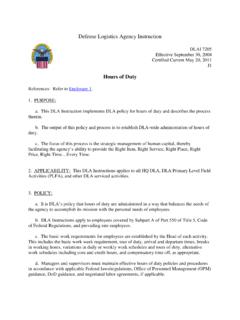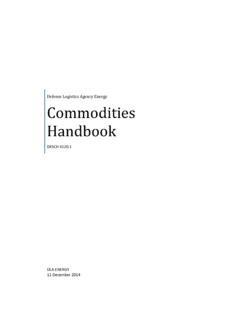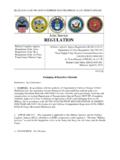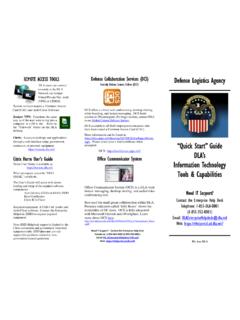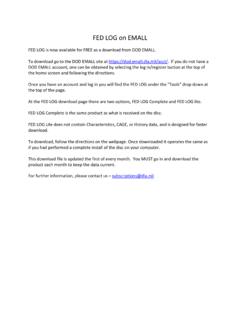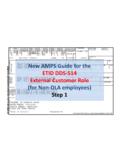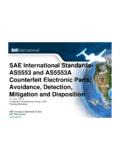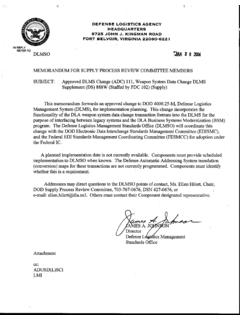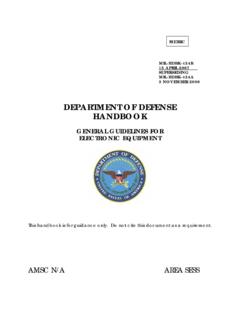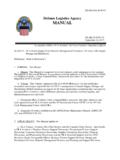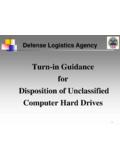Transcription of Instructions for turn in of hazardous material and …
1 Instructions for turn in of hazardous material and waste The following guidance outlines procedures for the turn -in of hazardous material (HM) for R/T/D/S, hazardous waste (HW), and other types of wastes ( , PCBs, Friable Asbestos, etc.). Some HW may require disposal on a hazardous waste disposal contract in compliance with federal/state/host nation regulations, when discarded for disposal. These procedures are intended to assist commanding officers, accountable supply officers, environmental staff and generating activities in the day-to-day conduct of business with the Disposition Services site. It is not possible to identify the universe of regulatory requirements in this guidance, however, basic turn -in requirements are addressed. To ensure compliance with federal, statue and/or DoD regulations, it is necessary that turn in activities obtain and become familiar with applicable Codes of Federal Regulation (CFRs), state regulations, DoD regulations, and overseas, by the OEBGD or the Final Governing Standards (FGS) for the host nation.
2 A current list of the predominant hazardous property is found here: Federal Stock Classes (FSCs). Entries below contain generator/installation responsibilities for hazardous property having special turn -in requirements. For this property, the Disposition Services siste may accept or not accept, accountability and/or physical custody. (Also see DoD , Chapter 10, Paragraph B.) Summary of Preparatory Steps Detailed turn -in requirements are outlined at ensuing paragraphs. Your servicing Disposition Services site is available to provide additional information and assistance in preparing hazardous property and documentation for turn -in. a. Identify the property (HM or HW, other ( , PCBs), NSN/LSN, nomenclature or chemical name, quantity) b. For HM: (1) material Safety Data Sheet (MSDS) The MSDS is an OSHA requirement levied on chemical manufacturers to provide specific information about the chemicals they produce and sell. The MSDS must accompany the product(s) when sold.
3 Subsequently the buyer, or whoever uses the chemicals, must maintain the MSDS in their plant or storage area, to ensure the MSDS information is available for the safety of the employees who use or handle the chemicals. The MSDS is prepared by private industry and must be prepared by professional chemists and/or industrial hygienists who know and understand the chemical and physical properties of the chemicals, and who sign and verify its correctness. OSHA (29 CFR) provides a specific outline of what must go in an MSDS. DRMO or DoD employees (unless they are chemists or industrial hygienists who has responsibility to prepare MSDSs)do not prepare, verify or sign an MSDS. There is no specific form number assigned the MSDS. The DoD hazardous material Information Sheet (HMIS) is the closest DoD format to a MSDS. For MSDS' that are not in the DoD HMIS, a generator should call the manufacturer of the hazardous material and request an MSDS for the specific report (2) hazardous Chemical Warning Label (DD Form 2521 / 2522) on package (3) Packaging, marking, labeling of property (4) DoT Shipping Paper, if transporting HM off-site c.
4 For HW: (1) Characterize the waste and prepare a hazardous waste Profile Sheet (HWPS) (2) Use user's knowledge of waste or lab analysis or other identifying information (3) Packaging, marking, labeling of property (4) hazardous waste Manifest, Land Disposal Restriction(LDR), if transporting HW off-site d. For PCBs, gas chromatography lab analysis, PCB marking on PCB Items e. Condition of Property - Non-leaking, safe to handle f. Packaging and transportation according to 49 CFR, if transporting HM/HW off-site g. Provide disposal funding information for the DTID (MILSBILLS fund code, Bill to DoDAAC, Contract Line Item Number (CLIN) cost per lb., Total CLIN Cost. h. Prepare a DD Form 1348-1 or 1A, Disposal turn -in Document. i. Coordinate pre-inspection, if required, and/or scheduleturn-in time with the Disposition Services site. Identification of hazardous Property a. hazardous Property (HP) must be properly identified. Your responsibilities includes identifying hazardous property as either hazardous material (HM) or as hazardous waste (HW) based on the definitions of HM and HW in DoD and various federal/state/local/foreign country laws and regulations.)
5 The following guidance is based on DoD policy and shall be used in conjunction with applicable federal, state, and/or local environmental regulations. b. hazardous material (HM). Generally unused, unopened items capable of use as originally intended. (1) Any material that is capable of posing an unreasonable risk to health, safety, and property during transportation under DOT or the International Maritime Dangerous Goods Code of the International Maritime Organization. (2) DOT hazardous materials appear in the hazardous material Table (49 CFR ). DOT defines a number of hazard classes ( , flammable liquid, corrosive material , oxidizer, etc.) which establish the parameters a material must be measured against to determine if it is a hazardous material . (3) The hazardous Materials Table in 49 CFR lists hazardous materials by chemical name; however, the table also contains general hazard class materials ( , flammable liquid, ) to cover materials not listed by name.
6 (4) Any item that is hazardous in accordance with OSHA, TSCA, or other federal, state, local agency or regulation. (5) An item, which in the normal course of operation or use, may produce hazardous dusts, gases, fumes, vapors, or mists. (6) An item, due to its characteristics, which in the opinion of its manufacturer could cause harm to personnel if used or stored or disposed of improperly. c. hazardous waste . Generally used, opened, damaged, contaminated, or expired materials that are no longer capable of being used for its intended purpose without undergoing some type of processing. (1) Any item that is regulated under RCRA or state regulation as a hazardous waste . From a practical standpoint, if an EPA/State waste number can be assigned, then the item is a hazardous waste . (2) The item must first be a solid waste as defined in 40 CFR If a solid waste , the item must meet one or more of the criteria listed below to be a hazardous waste : (3) It is a listed waste as described in 40 CFR 261 Subpart D.
7 (4) The item exhibits one of the characteristics of a hazardous waste in 40 CFR 261 Subpart C (ignitability, corrosivity, reactivity, toxic characteristic). (5) If a waste is neither listed nor exhibits a characteristic, it may still be regulated as a hazardous waste . Under RCRA, states are allowed to designate additional wastes as hazardous . These wastes must be treated in the same manner as a RCRA hazardous waste in the state. d. Polychlorinated Biphenyls (PCBs) (1) The Toxic Substances Control Act and 40 CFR 761 regulated PCBs while in use and for disposal. State and host nation regulations may differ and should be consulted prior to taking disposal action. For turn -in of PCB Items or PCB wastes to the DRMO, for R/T/D/S or ultimate disposal, the following basic requirements apply. (2) Laboratory analysis by gas chromatography (GC)/Electron Capture Detector, except for hermetically sealed items, or, items having a manufacturer's nameplate that indicates the presence of PCBs ( , generic or commercial name such as Askarel, Pyranol, or others).
8 (3) Indicate concentrations of PCBs in parts per million ( , the federal regulatory ranges in ppm are - 2 ppm or less, less than 50 ppm, 50-499 ppm, 500 ppm or greater) (4) PCB hazardous property must be enclosed, non-leaking, and safe to handle. (5) PCB property at concentrations greater than 50 ppm will be marked with a PCB label, per 40 CFR Transportation of PCBs will be in accordance with Department of Transportation regulations at 49 CFR. (6) Property which may contain PCBs: electrical transformers; electrical capacitors; mining equipment; electric motors; heat transfer system pumps; hydraulic systems; dairylide and phthalocyanine paint pigments; conveyor system electromagnets; natural gas pipeline compressors; waste oil; fluorescent light ballasts; air conditioners; microwave ovens; television sets; circuit breakers, reclosers and cable; voltage regulators, switches and sectionalizers. e. Asbestos. (1) Regulated asbestos containing material (RACM) is: friable asbestos; Category I nonfriable ACM that has become friable; Category I non-friable ACM that will be or has been sanded, round, cut or abraded; Category I non-friable ACM that has a high probability of becoming or has become crumbled, pulverized or reduced to powder during demolition or renovation.
9 (2) Asbestos waste is regulated for disposal under the waste disposal standards at 40 CFR (3) Friable asbestos must be sealed in leak tight containers or wrappings. (4) Containers or wrapped materials must be labeled as follows IAW 29 CFR (j)(2): DANGER CONTAINS ASBESTOS FIBERS AVOID CREATING DUST CANCER AND LUNG DISEASE HAZARD (5) Vehicles must also be marked per 29 CFR 145(d)(4). (6) The labels must be printed in letters of sufficient size and contrast to be readily visible and legible. The label must contain the name and address of the generator. (7) A waste shipment record (Click here for sample) used to track and substantiate the disposition of asbestos waste material is required to be originated and signed by the waste generator. hazardous Property Requiring Special Processing The list below is property requiring special processing, which is subject to unique regulatory constraints, because of the nature of the property or its container.
10 Some types of property may be processed for R/T/D/S, and other property on the list, may have to be processed directly to disposal. See disposal guidance in DoD , Chapter 10, Attachment 1. Asbestos Asbestos contaminated safe/file cabinets Batteries Blast media Carbon composite fiber material Chemical Defense Equipment (CDE) Chlorobromomethane/Bromochloromethane (CB) fire extinguishers Compressed gas cylinders Containers (empty) Dental amalgam Drugs and Biologicals (FSC 6505) Epinephrine sharps Fluorescent lamp ballasts Fluorescent light tubes and high intensity discharge lamps (HID) Lab packs for small quantity chemical items Liquid rocket propellants and associated products Medical waste Mercury vapor lamps Metalworking machines Oil (used oil) Opened containers Organic peroxides Overpacked HM Ozone depleting substances (ODS) Pesticides Polychlorinated biphenyls (PCB) Radioactive mixed waste Refrigeration Equipment (Scrap regulated by 40 CFR )
